
Featured image: Sally Mann, Bloody Nose. c 1991. Collection of Sally Mann.
All images © Sally Mann.
Beauty and Brutality in Sally Mann’s South
A Thousand Crossings reveals Sally Mann as an artist boldly operating on her own terms
By Louis Corrigan
Beauty is not an aesthetic quality universally embraced by contemporary artists. For decades, most have taken a conceptual approach, as if abstract ideas were inherently more consequential, less tainted somehow, than sensual connection. But Sally Mann has always risked beauty, noting that artists from the South have traditionally displayed “a conspicuous willingness to use doses of romance that would be fatal to anyone else.”
Mann, who originally studied literature, not photography, has said that reading Faulkner in boarding school “threw wide the door of [her] ignorant childhood” regarding the horrific legacy of slavery. Yet, even with this in mind, she continued to write rhapsodic poems about the “profligate physical beauty” of the Southern landscape, especially her beloved Shenandoah Valley.
These seemingly contradictory impulses–to exalt natural beauty and to discern latent brutality–run throughout the images in the new traveling exhibition Sally Mann: A Thousand Crossings at the High Museum. Although not a retrospective, the landmark show, co-curated by Sarah Greenough of the National Gallery in Washington, D.C., and newly appointed High photography curator Sarah Kennel, offers the most extensive presentation yet of the photographer’s career.

Sally Mann, Last Light, 1990, gelatin silver print, Joseph M. Cohen Family Collection.
Mann originally secured her place in the art historical canon with her 1992 series Immediate Family. In luminous black-and-white images, she captured her children in sometimes naked play in the prelapsarian setting of her family’s Maury River cabin near Lexington, Virginia. These photographs made Mann both famous and controversial: Time magazine called her “America’s best photographer” while many critics expressed concern that her work exploited her children and was even akin to child pornography.
The exhibition includes a selection from the famous Family series, but it primarily focuses on later work inspired by the South’s physical beauty and violent history. The show makes the case that Mann’s experimentation with old photographic processes led her to new expressive possibilities that have allowed her to pursue deeply human–and perhaps inherently literary–questions about memory, trauma, death, and the persistence of nature. Mann’s grappling, as a white woman, with issues of African American history and identity sometimes falls flat. Yet even her relative failures underscore the honest questioning and seriousness of intent that have long marked Mann as the real deal, an artist boldly operating on her own terms.
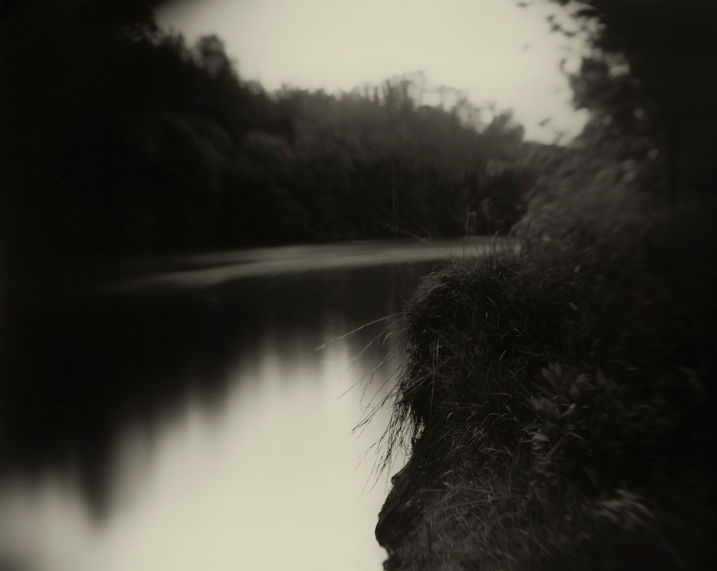
Sally Mann, Untitled (Niall’s River, Virginia), 1994. Collection of National Gallery of Art
Mann fleshed out those terms in her extraordinary book Hold Still: A Memoir with Photographs, nominated for the 2015 National Book Award, in which she digs deep into her family’s history to make sense of her own life and creative preoccupations.
Born in 1951 in Lexington, Mann grew up in a still segregated old Virginia, but with highly educated liberal parents. Her mother, from Boston, ran the bookstore at Washington and Lee University. Her father, from Dallas, was a doctor with a passion for art-making and an obsession with death. Both were emotionally distant, so for love and support she turned to Virginia “Gee-Gee” Carter, an African American housekeeper who worked for the family for nearly 50 years. Mann describes herself as a “near-feral child” who refused to wear clothes until age 5. As a pre-teen, she spent days by herself riding her horse bareback around the lush Virginia countryside.
This freedom and connection to nature fed into how she and her husband Larry raised their own kids, and the Family series reflects that. Mann began seriously photographing her three young children — Emmett, Jessie and Virginia – in 1985 using a traditional large format 8 x 10 camera. From the negatives she made meticulous silver gelatin prints, some 200 different images in total, a third of which appeared in the book. From 1990 to1994, Mann also used a handheld camera to take 1,800 more casual and less often seen color images, several included in the show.
Some shots in Family came as felicitous gifts caught live in a single take. Most were more studied, originating in something her children did that led Mann to ask them to pose as actors in a scene until she got the image just right. Her memoir reveals eight images taken over as many days to perfect The Last Time Emmett Modeled Nude. The published photo shows her son warily trailing his hand in the river, enclosed in the foreground by the double V of light from the sky and its reverse reflection in the water as dusk darkens the trees along the shore. The picture has a mythic quality as Mann combines the strength of personality of her son with the beauty of the river via the formalist magic of darkened edges and the narrow point of focus on Emmett. Similarly, Last Light captures the curly blonde Virginia aglow and lightly held by her father in a pieta-like pose, another case of Mann transmuting casual everyday interactions into something timeless.

Sally Mann, The Ditch, 1987. Courtesy of The Art Institute of Chicago.
This melding of the real with the fictive makes the work unsettling, especially for some critics who charged Mann with exploiting her children and even aestheticizing trauma due to the numerous pictures of injured children, such as Damaged Child, a close-up of a young Jessie with her eye swollen from an insect bite. Others accused Mann of putting her children and others at risk from pedophiles by publishing the photos.
Mann does present children with a complexity at odds with a sentimental view of their innocence. Jessie, a future model and photographer, was often the lead actor, not just powerfully petulant in Jessie Bites but disarmingly adult in Candy Cigarette and others. Curator Kennel’s nuanced catalog essay highlights how the era’s evolving laws protecting against child pornography also had the paradoxical effect of “requiring adults to assume the gaze of a pedophile” to police against such images. That increasingly foreclosed the depiction and acknowledgement of the kind of normal childhood sexuality that runs through the Family series.
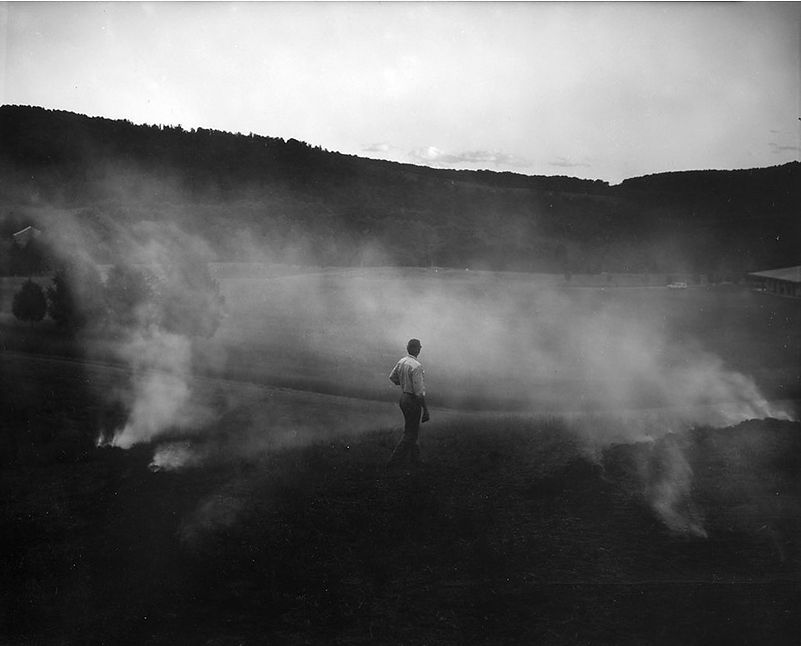
Sally Mann, The Turn, 2005, Sally Mann, gelatin silver print. Private collection.
As the children began to recede from her images, her beautiful Virginia landscape took over, unleashing Mann’s full romantic streak with its risks of sentimental nostalgia. In 1996 the High offered Mann its first commission for Picturing the South, a now long-running series, featuring numerous photographers, which the High will present in its entirety in 2021. This commission took her to Georgia and spurred ensuing travels to Alabama, Mississippi and Louisiana (featured in her book Deep South). This shift to less personal Southern terrain re-opened a Faulknerian sensibility about how the violent past is not dead but still inscribed in the land. But how to capture that?
In her early 20s, Mann had discovered thousands of large glass negatives from the 1860s made with the difficult wet-plate collodion process by photographer Michael Miley. Some images even depicted her family’s section of the Maury River. She spent two years cleaning and cataloguing this work and making prints of more than a thousand of them. As Malcolm Daniel explains in an excellent catalog essay on Mann’s technical experimentation, collodion represents a main line of 19th century photographic history, perfected by the likes of Carleton Watkins with his famous images of the American West. Yet collodion offers specific visual possibilities because it isn’t equally sensitive to all colors. It registers blue, violet and ultraviolet strongly, but other colors appear more like black.
Also, Mann was drawn as much to the imperfections or what she saw as “happy accidents” in Miley’s work, as dust or uneven collodion coating led to visual distortions such as light leaks, fogging, flares and odd solarization. She adopted this process beginning with her Deep South images, using a darkroom in the back of her SUV. She intentionally accentuated such “accidents,” often to convey a landscape’s hauntedness.
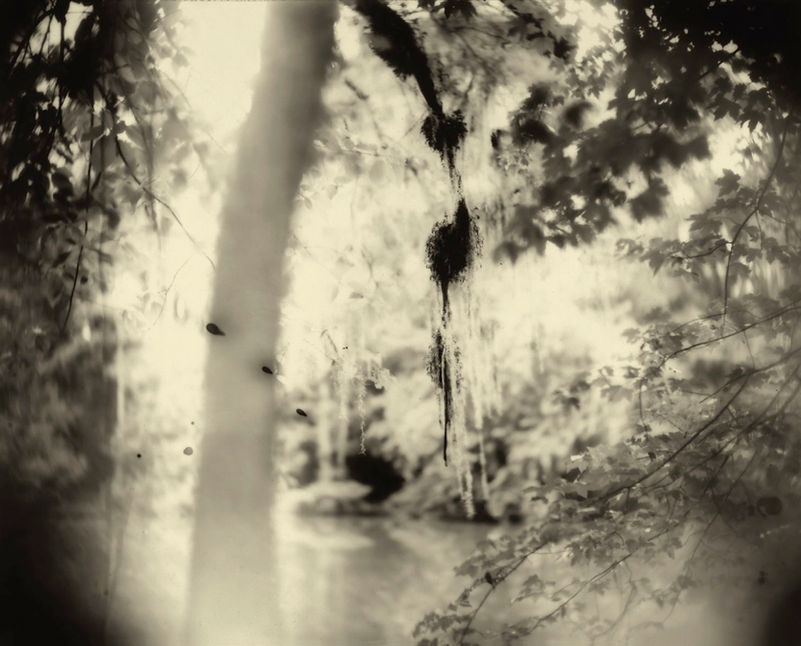
Sally Mann, Deep South, Untitled (Three Drips), 1998, printed 1999, National Gallery of Art, Washington.
Mann’s Last Measure series (2000 – 2003) took this further, capturing Civil War battlefields by deploying this collodion technique to create symbolist gems. Though hardly a Union victory, the Battle of Antietam in September 1862 was enough of a tactical win to allow President Lincoln to issue the preliminary Emancipation Proclamation four days later. Yet it’s said to be the single bloodiest day in American military history, with nearly 23,000 dead and wounded on both sides. Mann’s large, darkly expressive silver gelatin prints of this battlefield present nature seemingly reverberating with the trauma of such violence. The work loosely suggests a narrative as an apparent conflagration in the fields in Antietam (Cornfield) blackens the landscape and blocks out the sun in the nightmarish Antietam (Black Sun). The natural beauty of the tree line returns in Antietam (Starry Night) but the image appears literally shot through and crumbling. What remains are just fortification mounds that could be graves in Antietam (Trenches).
In the later but related Blackwater series (2008-2012), Mann ventured into the challenging terrain of Virginia’s Great Dismal Swamp and the forests around the Blackwater and Nottoway rivers that provided refuge for African Americans who escaped enslavement. Again, she experiments with old photographic methods, here taking color digital images but manipulating their color on a computer before re-photographing the printed image to produce metal tintypes, another format from the 1860s. The images include highly abstract pieces like Blackwater 20, which looks like an expressionist ink drawing, but also more clearly photographic pieces like Blackwater 15, with its chaotic, reflective thickets of trees and water and a hint of passage through a dark, broken landscape.
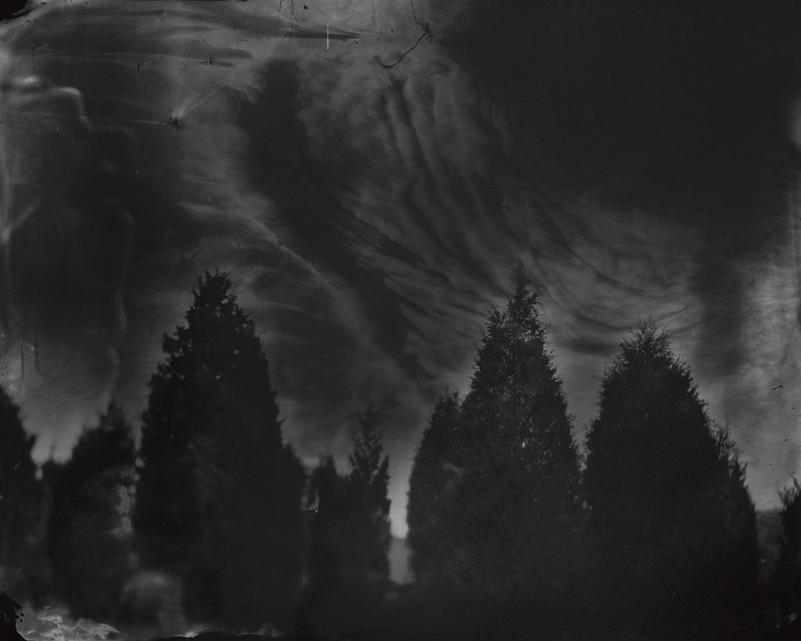
Sally Mann, Battlefields, Fredericksburg (Cedar Trees), 2001, gelatin silver print, printed 2003, Waterman/Kislinger Family
Such images seem to ask photography to do something that it cannot really do. We may know the history of a place, the trauma experienced there. We may find physical remnants of that suffering, such as earthworks from battle trenches. We may feel a landscape’s hauntedness as we imagine what passed there. Yet that’s not some force emanating from the land itself in a way that can be captured by light and chemical processing. Nature often seems oblivious to its human history. The images Mann creates, then, are fictions, necessary and perhaps explanatory, at least at an emotional level.
One of Mann’s earliest attempts to take account of the South’s violent racist history came in her 1998 visit to Mississippi’s Tallahatchie River where 14 year old Emmett Till was brutally murdered by two white men in 1955, a horror that helped fuel the Civil Rights Movement. The exhibit includes three quietly symbolic, collodion based images taken around the river, including one of the riverbank where Till’s mutilated body was recovered. Mann’s account of this site is striking. “Having pushed our way through the thick brush and scraggly trees to get to the riverbank, I was disappointed by the humdrum, backwashy scene before me. How could a place so weighted with historical pain appear to be so ordinary?” But looking closer with her “photo eyes,” Mann did find “something mysterious about the spot” and “when I released the shutter I asked for forgiveness from Emmett Till.”

Sally Mann, Blackwater 15, 2008-2012, Collection of the artist
As co-curator Greenough notes, what Mann found in Emmett Till River Bank was a gash in the earth, suggesting a lingering wound, and she “shot into the sun, allowing it to flood the heinous scene with light.” Mann’s imperfectly coated collodion plate creates a vignetting around the edges of the nearly abstract milky center, making the image appear “as if seen through the lens of time,” in Greenough’s apt phrasing.
Viewers will likely disagree about whether such images resonate, especially in the way Mann might wish. The photographs seem more an exercise in white guilt than truly “redemptive,” as historian Drew Gilpin Faust argues in her catalog essay. Moreover, there can be a banality to evil, as Hannah Arendt noted, especially the widely practiced institutionalized violence of the Jim Crow South. To seek the “mysterious” is perhaps to obfuscate what was shockingly ordinary — another lynching in the Deep South. Yet, how would you make a picture of an “ordinary” riverbank signify?
The most poignant section of Mann’s memoir discusses Gee-Gee, the family housekeeper whom Mann loved like a parent. Mann asks, could such a relationship “ever have been honest, untainted by guilt or resentment?” She thinks so, but she is shocked, two decades after Gee-Gee’s death in 1994, by her own blindness and silence about this strong woman who endured all the hardships of a racist South and yet somehow managed to send all of her six children to college. Gee-Gee appears in several of the Family photos entitled The Two Virginias, paired with Mann’s youngest daughter in an intimate, lovely contrast of young and old. Gee-Gee is clearly part of the family, and yet she is not fully seen–mainly aged hands, swollen legs, wrinkled skin, a shock of white hair.
Mann’s self-indictment seems to motivate a number of her projects since 2006, including the numerous black-and-white photos (2008-2016) of old white clapboard Baptist or Methodist African American churches spread around the rural countryside near her home. Photographed with high contrast Ortho film, many of these pieces beautifully render a spiritual glow of light (Oak Hill Baptist) or a sense of disappearance (Mt. Tabor United Methodist). Yet these photos of architectural exteriors keep us on the outside, even separated in time, from the vitality of the congregants, the sense of community and even ecstasy that Mann experienced attending service with Gee-Gee.
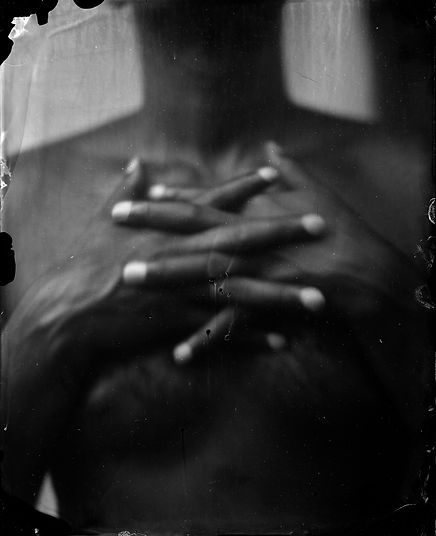
Sally Mann, Men, Janssen, 2006-2015, Collection of the artist.
Perhaps the show’s most problematic series is Men (2006-2015) featuring hazy images of young, shirtless African American males. These pictures are intimate, not unlike Mann’s depictions of her husband, but they don’t feel personal even when you are looking at an extreme close-up of a named man’s face as in Men, Stephen. There’s an elusive quality to the figures, as if Mann is trying but failing to see them. That is, in fact, part of the project’s impetus. “What I want to do is find out who those black men were that I encountered in my childhood, men that I never really saw, never really knew,” she says in her memoir.
Each work grew out of a one hour session with a paid model that she had not previously known. She clearly is not simply creating a “voyeuristic inventory of my models’ physical properties.” Yet a template for this series comes from two works that address black enslavement: choreographer Bill T. Jones’s dance piece Fondly Do We Hope…Fervently Do We Pray, which reworked Walt Whitman’s famous poem I Sing the Body Electric. The latter does present a celebratory inventory of the body. Both artists, Mann says, “sought the person inside the auction-block property, speaking about slaves as human beings, about their humanity, about, to get right down to it, their physical bodies.”
Whitman conceptually elided body with soul, so one can appreciate Mann’s logic while finding it inadequate: bodies are not people. Perhaps inevitably today, any white artist photographing young African American men in this way will be seen as objectifying them, turning them into a different form of property (here, a one hour rental). To see and really know people requires a different act of engagement and listening to find a shared humanity. That’s what Mann accomplished in her powerful early series At Twelve (1988, unfortunately not part of this exhibit), with its insightful portraits of Southern girls on the edge of womanhood.
The past few years have seen another wave of intense debate about how and whether white artists can address “blackness” or whether this is always cultural appropriation. In a striking catalog essay that connects Mann to her strongest Southern literary forebears, critic Hilton Als defends Mann’s right to make this work. “I think the artists who ‘get to’ speak are those who do justice to the country’s complexity, in work that is as complex, dense, strange and incomprehensible as the country that made them.”
It is worth noting in the context of Men that there’s a similarly inaccessible and even apparitional quality to most of Mann’s later images of people. That includes her long-running series on her once physically powerful husband in decline from late onset muscular dystrophy, the large close-ups of her children as young adults, and especially her darker than dark ambrotype self-portraits – all on view at the High.

Sally Mann, On the Maury, 1992, Private collection.
Mann has long asked where body meets soul and where each begins to slip from the other. She’s often pointed to Ezra Pound’s line: “What thou lovest well remains/ the rest is dross.” Yet beneath this hope is the fear (and comfort): very little remains of our human existence. We are always receding, our flesh aging and eventually consumed back into nature, as Mann depicts point-blank in her Body Farm series (2001, not included in A Thousand Crossings) of decaying corpses in a research field in Tennessee.
Mann is at her best when she addresses what she knows in her bones. Yet the excitement of Crossings is that so many of the images reveal Mann stretching to make sense of what she doesn’t know, but feels a moral imperative to understand. This provisional, experimental quality is what makes her work a welcome invitation to try to understand with her.

Louis Corrigan is an Atlanta-based writer. He has previously served on the boards of several Atlanta non-profit arts organizations.